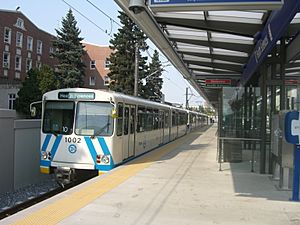Light rail facts for kids

Light rail or light rail transit (LRT) is a type of train system used in cities. It helps people travel around. Light rail is a form of public transportation. These systems usually carry fewer people and go slower than big subway or metro trains. However, they are often faster and carry more people than street trams.
Light rail trains are usually electric. They often run on their own special tracks. These tracks are separate from regular street traffic. Sometimes, though, light rail trains might share streets with cars. Modern light rail technology is very flexible. This means it can be used in many different ways. Whether a system is called a true rapid transit system depends on how it is built and used.
Contents
What is Light Rail?
Light rail systems use special electric trains. These trains are called electric rail cars. They are designed to move many people at once. Light rail is a key part of public transport in many cities. It helps reduce traffic and pollution.
How Light Rail Works
Light rail trains get their power from electricity. This electricity often comes from overhead wires. Sometimes, it comes from a third rail. The trains run on tracks, just like bigger trains. Most of the time, light rail has its own special path. This path is called a private right-of-way. This means cars and other traffic cannot use it. This helps the trains move quickly.
However, light rail can also be flexible. Some systems run on tracks in city streets. When this happens, they share the road with cars. This mix of private tracks and street running makes light rail unique.
Light Rail vs. Other Train Systems
It can be tricky to tell light rail apart from other trains. Here is how it compares:
- Trams: Trams usually run mostly on city streets. They often share lanes with cars. Trams are usually slower and carry fewer people than light rail.
- Heavy rail/Metro/Subway: These are much larger train systems. They are designed to carry huge numbers of people. They almost always run on their own tracks. These tracks are often underground or elevated. They are much faster than light rail.
Light rail often sits in the middle. It is faster and carries more people than a tram. But it is usually not as big or as fast as a subway.
Where Can You Find Light Rail?
Light rail systems are used all over the world. Many cities have built them. They help people travel to work, school, and other places. For example, the CTrain in Calgary, Canada, is a light rail system. The Docklands Light Railway in London, England, is another example. The TRAX system in Utah, USA, also uses light rail.
The first modern light rail line in North America was in Edmonton, Alberta, Canada. It opened in 1978. Cities like Los Angeles have expanded their light rail networks a lot. This helps many people get around. Light rail is a great way to make cities more connected.
Related pages
Images for kids
-
The light rail in Tunis, Tunisia, was the only light rail in Africa until 2015.
-
London's Docklands Light Railway is run by Transport for London.
-
The CTrain is a light rail system operated by Calgary Transit
-
SEPTA's 101 trolley pulling into 69th Street Terminal near Philadelphia
-
Metrolink in Manchester city center, England, is an example of street-level light rail
-
Sydney's Dulwich Hill Line is mostly situated on segregated tracks along a former heavy rail corridor
-
The Trillium Line in Ottawa was built along a freight railway and is still occasionally used by freight traffic overnight.
-
A light-rail vehicle on the Hämeenkatu street in Tampere
-
Metrotram in Kryvyi Rih (Ukraine) was separated from the streets, but later it was upgraded to be compatible with common tramways
-
A light-rail vehicle, a part of the TTC streetcar system in Toronto
See also
 In Spanish: Tren ligero para niños
In Spanish: Tren ligero para niños





























